Royal Netherlands Navy
| Royal Netherlands Navy Koninklijke Marine | |
|---|---|
|
The Navy jack of the Royal Netherlands Navy. | |
| Country |
|
| Branch | Armed Forces of the Netherlands |
| Type | Navy |
| Size |
10,500 active duty personnel 6 frigates 6 minehunters 8 helicopters and 20 on order/being delivered |
| Part of | Ministry of Defence |
| Headquarters | Den Helder |
| Motto(s) |
"Veiligheid op en vanuit zee." Security on and from the sea. |
| March | Royal Netherlands Navy Service Marchpast |
| Engagements |
Eighty Years' War Dutch–Portuguese War Anglo-Dutch Wars War of the Spanish Succession War of the Quadruple Alliance World War II |
| Commanders | |
| Commander | Lieutenant general Rob Verkerk |
| Deputy commander | Vice Admiral Rob Bauer |
| Notable commanders | Michiel de Ruyter, Maarten Harpertszoon Tromp, Jan van Speyk, Karel Doorman |
| Insignia | |
| Naval Ensign |
 |
| Naval Jack |
 |
| Aircraft flown | |
| Patrol | NH90 |
The Royal Netherlands Navy (Dutch: Koninklijke Marine, “Royal Navy”) is the navy of the Netherlands. Its origins date back to the Eighty Years' War (1568–1648), the war of independence from the House of Habsburg who ruled over the Habsburg Netherlands.
During the 17th century the navy of the Dutch Republic (1581–1795) was one of the most powerful naval forces in the world and played an active role in wars against England, France, Spain and several other European powers. The navy of the later Batavian Republic (1795–1806) and Kingdom of Holland (1806–1810) played an active role in the Napoleonic Wars, though mostly dominated by French interests. After the establishment of the modern Kingdom of the Netherlands (founded 1815) it served an important role in protecting Dutch colonial rule, especially in Southeast Asia, and would play a minor role in World War II, especially against the Imperial Japanese Navy.
After World War II, the Royal Netherlands Navy has taken part in expeditionary peacekeeping operations.
Bases
The main naval base is located at Den Helder, North Holland. Secondary naval bases are located at Amsterdam, Vlissingen, Texel, and Willemstad (Curaçao). Netherlands Marine Corps barracks are found in Rotterdam, Doorn, Suffisant on Curaçao, and Savaneta on Aruba.
Officer training
Officers of the Netherlands Navy are trained at the Koninklijk Instituut voor de Marine ("Royal Naval Institute"), which is part of the Nederlandse Defensie Academie ("Netherlands defence academy") in Den Helder.[1] Around 100–150 people start training every year.
Ship prefixes
An international prefix for Dutch navy ships is HNLMS (His/Her Netherlands Majesty’s Ship).[2] HNMS is also used,[3] although this can also refer to Royal Norwegian Navy ships.[4] The Dutch navy itself uses the prefixes Zr. Ms. (Zijner Majesteits, His Majesty's) when a king is on the throne, and Hr. Ms. (Harer Majesteits, Her Majesty's) when there is a queen.[5]
History
The modern Netherlands Navy dates its founding to a "statute of admiralty" issued by Holy Roman Emperor Maximilian I on January 8, 1488.[6] Naval historians trace the origins of an independent Dutch navy to the early stages of the Eighty Years' War (1568–1648) while the formation of a "national" navy is dated to the establishment of the Dutch Republic in 1597.[7]
Dutch Golden Age
.jpg)
The Dutch navy was involved in several wars against other European powers from the late 16th century, initially for independence against Spain in European waters, later for shipping lanes, trade and colonies in many parts of the world, notably in four Anglo-Dutch wars against England. During the 17th century the Dutch navy was one of the most powerful navies in the world. As an organization, the navy of the Dutch Republic consisted of five separate admiralties (three of them in Holland, and one each in Friesland and Zeeland), each with its own ships, personnel, shipyards, command structures and revenues.[8]
World War II
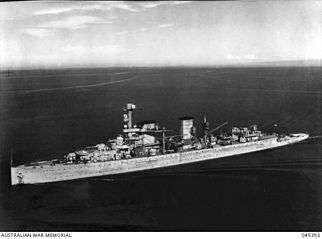

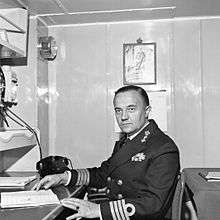
During the Second World War, the Dutch navy was based in Allied countries after the Netherlands was conquered by Nazi Germany in a matter of days: the Dutch navy had its headquarters in London, England, and smaller units in Ceylon (modern day Sri Lanka) and Western Australia.
Around the world Dutch naval units were responsible for transporting troops, for example during Operation Dynamo at Dunkirk and on D-Day, they escorted convoys and attacked enemy targets. During the war the navy suffered heavy losses, especially in defending the Dutch East Indies, most notably the Battle of the Java Sea in which the commander, Dutchman Karel Doorman, went down with his fleet along with 1,000 of the ships' crew. One Dutch light cruiser that was under construction was captured in its shipyard by Nazi Germany.
During the relentless Japanese offensive of February through April 1942 in the Dutch East Indies, the Dutch navy in Asia was virtually annihilated, and it sustained losses of a total of 20 ships (including two of its three light cruisers) and 2,500 sailors killed[9]—as much as the Americans at Pearl Harbor. The Dutch navy had suffered from years of underfunding and came ill-prepared to face an enemy with more and heavier ships with better weapons, including the Long Lance-torpedo, with which the cruiser Haguro sank the light cruiser HNLMS De Ruyter.[10]
A small force of submarines based in Western Australian sank more Japanese ships in the first weeks of the war than the entire British and American navies together during the same period, an exploit which earned Admiral Helfrich the nickname "Ship-a-day Helfrich".[11] The aggressive pace of operations against the Japanese was a contributing factor to both the heavy losses sustained and the greater number of successes scored as compared to the British and Americans in the region.
Both British and American forces believed that the Dutch admiral in charge of the joint-Allied force was being far too aggressive. Later in the war, a few Dutch submarines scored some remarkable hits, including one on a Kriegsmarine U-boat in the Mediterranean Sea.
Netherlands New Guinea
After the war, the relations between the Netherlands and its colonies changed dramatically. The establishment of the Republic of Indonesia, just two days after the Japanese surrender, thwarted the Dutch plans for restoring colonial authority. It took four years of war before the Netherlands acknowledged the independence of Indonesia.
Part of the Dutch Navy was next stationed in Netherlands New Guinea until that, too, was turned over to the Indonesian government in 1962. This followed a campaign of infiltrations by the Indonesian National Armed Forces, supported by modern equipment from the Soviet Union, that was nevertheless successfully repulsed by the Dutch navy. These infiltrations took place after the order of President Sukarno to integrate the territory as an Indonesian province.
NATO cooperation
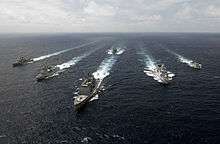
With the creation of the North Atlantic Treaty Organisation, the military focus was on the army and air force; it was not until the Korean War (1950–53) that the navy got more recognition. The government allowed the creation of a balanced fleet consisting of two naval squadrons. Apart from the aircraft carrier HNLMS Karel Doorman the Dutch navy consisted of two light cruisers (two De Zeven Provinciën-class), 12 destroyers (four Holland-class, eight Friesland-class), eight submarines, six frigates (van Speijk-class frigates), and a considerable number of minesweepers.
As a member of NATO, the Netherlands developed its security policy in close cooperation with other members. The establishment of the Warsaw pact in 1955 intensified the arms race between West and East. Technical innovations rapidly emerged, the introduction of radar and sonar were followed by nuclear weapon systems and long-range missiles. The geopolitical situation allowed for a fixed military strategy. Beginning in 1965, the Dutch Navy joined certain permanent NATO squadrons like the Standing Naval Force Atlantic.
Current structure
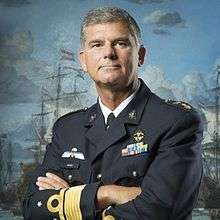
The constituent parts of the Royal Netherlands Navy are:
Naval squadron
Contains all surface combatants, replenishment ships, and amphibious support ships.
Submarine service
Contains the submarines and a support vessel.
Mine Detection and Clearing Service
Contains various minehunters.
Hydrographic Survey
Hydrographic surveys are carried out by the Dutch Hydrographic Service (Dienst der Hydrografie).
Naval aviation
- Two helicopter squadrons
Netherlands Marine Corps
- One Marine Training Command (MTC) (formerly known as GOEM: Groep Operationele Eenheden Mariniers)
- Two Operational Marine Combat Groups (1 MCG AND 2 MCG)
- One Maritime Special Operations Force (NLMARSOF)
- One Surface Assault and Training Group (SATG)
- One Seabased Support Group (SSG)
- One rifle company (32 Raiding Squadron.)is permanently stationed at Aruba
Netherlands Coastguard
Although the Netherlands Coastguard is not an official part of the Navy, it is under its operational control. Also the Dutch Caribbean Coast Guard is under the operational control of the Navy and is commanded by the commander of the Navy in the Caribbean.
Equipment
The Royal Netherlands Navy currently operates 7 main classes of vessels:
- Note: in the Royal Netherlands Navy frigates are interchangeable with destroyers as there is no separate class
| Type ship | Defensenote 1974 | Defensenote 1984 | Priority Document 1993 | Navy study 2005 | Economize 2011 |
|---|---|---|---|---|---|
| LC frigates | 4 | 4 | |||
| M frigates | 4 [12] | 8 [13] | 8 | 2 | 2 |
| GW frigates | 2 | 2 | 2 | ||
| L frigates | 1 [14] | 2 | 2 | ||
| S frigates | 12 | 10 | 6 | ||
| MLM frigates [15] | 6 | ||||
| Frigates | 25 | 22 | 18 | 6 | 6 |
| Patrol ships | 4 | 4 | |||
| Submarine | 6 | 6 | 4 | 4 | 4 |
| Supply ships | 2 | 2 | 2 | 1 | |
| ATS | 1 | 2 | 2 | ||
| JSS | 1 | 1 | |||
| Minehunters | 15 | 15 | 15 | 10 | 6 |
| Minesweepers | 11 | 11 [16] | |||
| Total ships | 59 | 56 | 40 | 28 | 23 |
| LRMP Aircraft | 21 | 13 [17] | 13 | ||
| Helicopters | 36 [18] | 30 [19] | 20 | 20 | 20 |
| Total aircraft | 57 | 43 | 33 | 20 | 20 |
* The Dutch Royal Navy classifies the De Zeven Provinciën-class as frigates, but internationally they are most comparable to destroyers (due to their size and weapon capability) platform for Sea Based Anti-Ballistic Missile defence
Naval aviation – maritime helicopters
- 20 NH90, 12 NATO Frigate Helicopter (NFH) and eight transport version of the NATO Frigate Helicopter (TNFH) for Marine Corps Air Lift Helicopter Squadron [20]
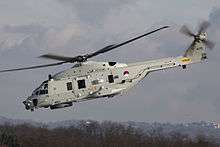
In 2012 an Apache attack helicopter from the Royal Netherlands Air Force made a deck landing on board HNLMS Rotterdam for the first time as part of an initial study into the possibilities for wider use of the helicopters.
The Dutch amphibious support ship HNLMS Johan de Witt and the HNLMS Karel Doorman JSS are designed to handle Royal Netherlands Air Force CH-47 Chinook helicopters. But these are not capable of sustained maritime operations due to lack of anti-corrosion measures.
Armored vehicles (Marine Corps)
- 156 BV206S armored all-terrain personnel carriers (127 will get a Mid-Life Update, the rest will be disposed of or sold)
- 74 BVS10 armored all-terrain personnel carriers
- 20 Bushmaster Mine-Resistant Ambush Protected
- 4 Leopard 1 BARV beach armored recovery vehicles
Unarmored vehicles (Marine Corps)
- Land Rover Defender
- 40 Mercedes-Benz 280 CDI
- 17 Unimog 1.2-ton truck
- Various DAF trucks
Artillery (Marine Corps)
- L16A2 81 mm mortar
- Brandt MO-60-V – 60 mm commando mortar
Personal weapons
- Colt Canada C7NLD – 5.56×45mm NATO assault rifle
- Colt Canada C8NLD – 5.56×45mm NATO carbine
- Glock 17M – 9×19mm Parabellum semi-automatic pistol (the M in Glock 17 stands for Maritime)
- FN MAG – 7.62×51mm NATO general purpose machine gun
- M2HB-QCB – .50 BMG heavy machine gun
- Steyr SSG – 7.62×51mm NATO sniper rifle
- Accuracy International AWM – .338 Lapua Magnum sniper rifle
- Barrett M107 – .50 BMG anti-materiel sniper rifle
- Heckler & Koch MP5 – 9×19mm Parabellum submachine gun
- FN P90 – 5.7x28mm submachine gun
- Mossberg M590A1 – 12 gauge shotgun
- AT4 – anti-tank weapon
- Panzerfaust 3 – anti-tank weapon
- GILL – anti-tank missile
- FIM-92C Stinger – man-portable surface-to-air missile
2012 future naval inventory
In 2012 the new fleet plan of the Royal Netherlands Navy was completed, consisting of these ships:
| Class | Photo | Type | Number | Dates | Details |
|---|---|---|---|---|---|
| De Zeven Provinciën class | .jpg) | Frigate | 4 | 2002 | Mainly Anti-Air Warfare with ABM capability, ASW and with extensive Command & Communication Facilities. Type identified by the Dutch as frigates but internationally are considered destroyers. |
| Karel Doorman class | .jpg) | Frigate | 2 | 1994 | 8 initially built for the Dutch navy, pairs of ships subsequently sold to the Belgian Navy, Portuguese Navy and Chilean Navy. Belgian and Dutch M-Class frigates recently received extensive upgrades such as an extended helicopter deck and new advanced sensors and improvements in stealthiness. |
| Holland class | 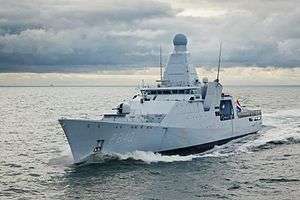 | Offshore Patrol Vessel | 4 | 2011 | Ocean patrols |
| Alkmaar class |  | Minehunter | 6 | 1989 | Minehunting/Minesweeping (combined), Initial class of 15 ships, will be replaced 2025 |
| Karel Doorman class | 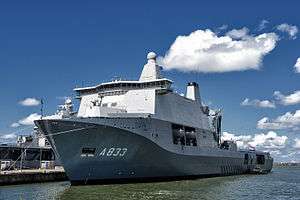 | Joint Logistic Support Ship | 1 | 2014 | Combined Amphibious Operations/Seabased Helicopter Platform & Fleet Replenishing, capable of supporting CH-47/AH-64/NH-90 Operations. |
| Rotterdam class | | Landing Platform Dock | 2 | 1998/2007 | Troop & Equipment Transport, Helicopter Platform with Command & Communication & Hospital Facilities |
| Walrus class | _in_2008.jpg) | Submarine | 4 | 1994 | Multi-purpose Diesel-electric powered hunter-killer submarines for Deep Ocean Operations and Brown Water & Special Force Operations. SLEP 2015–2017, will be replaced by 4 new subs from 2025 onwards. |
| Cerberus class |  |
Diving Support Vessel | 4 | 1992 | Multi-purpose Diving Support Vessels & Harbour Protection |
| Pelikaan class | 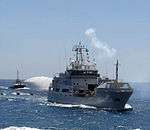 |
Logistic Support Vessel | 1 | 2006 | Multi-purpose Logistic Support Vessel Based in Dutch Caribbean |
| Mercuur class |  |
Submarine Support Vessel | 1 | 1987 | Submarine Support Vessel. Under modification (2015–2017) |
| Snellius class |  | Hydrographic Survey Vessel | 2 | 2004 | Multi-purpose Hydrographic Survey Vessel |
The total tonnage will be approx. 140,000 tonnes. Next to these ships a lot of other smaller vessels remain in the navy like the Snellius-class hydrographical survey vessels.
With these changes the Royal Netherlands Navy will have 10 large oceangoing vessels ranging from medium/low to high combat action ships. The renewed Dutch Navy will be a green-water navy, having enough frigates and auxiliaries to operate far out at sea, while depending on land-based air support, and, with the large amphibious squadron, they will have significant brown-water navy capabilities.
Future changes
- The Walrus-class submarines are currently undergoing a Mid-Life Update, including new sonar, new optronic periscope and weapon upgrades for near shore operations. Plans to replace the current 4 subs in 2025 were announced in November 2014. The Royal Dutch Navy is evaluating international cooperation.
- Upgrading the De Zeven Provinciën class LCF frigates Theatre Ballistic Missile Defense and considered SLCM integration.
- Replacement of the Karel Doorman class M frigates by 2023.
- Replacement of the Alkmaar class MCM ships by mid 2020s.
- Increasing the size of the Royal Netherlands Marine Corps to remain highly integrated with the British Royal Marines.
- The German Navy Seebatallion (Marines) will be integrated into the Royal Netherlands Marine Corps
- Cooperation with the German Navy regarding Submarine & Amphibious Operations.
Theater ballistic missile defense
Together with the United States and several other NATO members, the Dutch Navy is testing and updating its ships for Tactical ballistic missile defense capability. Although tests conducted concerning the capability of the APAR (Active Phased Array Radar) have been very successful, no decision has been made by the Dutch Government in purchasing SM-3 missiles—mainly because the SM-3 is not operational yet. Four ships are being fitted out for tactical ballistic missile defense. If purchased (after US export approval) the four LCFs will be fitted out with only eight SM-3 missiles each, due to the high costs for each missile (approximately $2.5–$5 million).
Gallery
 HNLMS Rotte, Coastal tugboat
HNLMS Rotte, Coastal tugboat HNLMS Urania, Sail training ship
HNLMS Urania, Sail training ship HNLMS Snellius, Hydrographic Survey Vessel
HNLMS Snellius, Hydrographic Survey Vessel HNLMS Nautilus, Dive Support Vessel
HNLMS Nautilus, Dive Support Vessel.jpg) HNLMS Mercuur, Torpedo Recovery Vessel
HNLMS Mercuur, Torpedo Recovery Vessel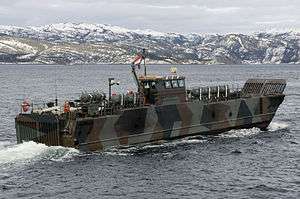 Landing Craft Utility MKII NL
Landing Craft Utility MKII NL
Historic ships
- several ships by the name of HNLMS De Ruyter
- several ships by the name of HNLMS Tromp
- HNLMS Bonaire
- HNLMS Schorpioen
- HNLMS Buffel
- Delft, 18th century fourth rate ship of the line
- De Zeven Provinciën, 17th century ship of the line and flagship of Michiel de Ruyter
By period
Koninklijke Marine, KM (Royal Netherlands Navy, RNLN)
Officers
| NATO code | OF-10 | OF-9 | OF-8 | OF-7 | OF-6 | OF-5 | OF-4 | OF-3 | OF-2 | OF-1 | OF(D) | Student Officer | ||
|---|---|---|---|---|---|---|---|---|---|---|---|---|---|---|
| (Edit) |
 |
 |
 |
 |
 |
 |
 |
 |
 |
 |
 |
Adelborst/Korporaal-Adelborst/Sergeant-Adelborst | ||
| Admiraal | Luitenant-Admiraal | Vice-Admiraal | Schout-bij-Nacht | Commandeur | Kapitein ter zee | Kapitein-luitenant ter zee | Luitenant ter zee der 1ste klasse | Luitenant ter zee der 2de klasse oudste categorie | Luitenant ter zee der 2de klasse | Luitenant ter zee der 3de klasse | ||||
| Abbreviation (stnd) | Adm of the Fleet1 | Adm | VAdm | RAdm | Cdre | Capt | Cdr | Lt Cdr | Lt | SLt or S/Lt | Mid | OCdt | ||
| 1 (due to tradition; actual rank abandoned in 1956) | ||||||||||||||
Enlisted ranks
| NATO Code | OR-9 | OR-8 | OR-7 | OR-6 | OR-5 | OR-4 | OR-3 | OR-2 | OR-1 | |||||||||||||||||||||||
|---|---|---|---|---|---|---|---|---|---|---|---|---|---|---|---|---|---|---|---|---|---|---|---|---|---|---|---|---|---|---|---|---|
| (Navy and Marine Corps) (Edit) |
 |
 |
 |
 |
 |
 |
 | |||||||||||||||||||||||||
| Adjudant- onderofficer |
Sergeant- majoor |
Sergeant | Korporaal | Matroos/ Marinier der 1e klasse |
Matroos/ Marinier der 2e klasse |
Matroos/ Marinier der 3e klasse | ||||||||||||||||||||||||||
| Abbreviation | WO1 | CSgt | Sgt | Cpl | L/Cpl | Mne | ||||||||||||||||||||||||||
| English equivalent | Warrant Officer | Chief Petty Officer | Petty Officer 1st Class | Petty Officer 2nd Class | Leading Seaman /Seaman | Seaman recruit | ||||||||||||||||||||||||||
| English equivalent (marines) | Warrant Officer | Sergeant Major | Sergeant | Corporal | Lance corporal/Marine 1st Class | Marine | ||||||||||||||||||||||||||
See also
- Netherlands Naval Aviation Service
- Ships of the Royal Netherlands Navy
- Military history of the Netherlands
- Military ranks of the Dutch armed forces
Notes
References
- ↑ "Koninklijk Instituut voor de Marine". defensie.nl. Retrieved 25 May 2016.
- ↑ "List of Acronyms Preceding the Name of a Ship". Corporation of Lower St. Lawrence Pilots. Retrieved 2013-07-31.
- ↑ See for example Paul M. Edwards (2010). Historical Dictionary of the Korean War. p. 114.
- ↑ See for example "King Harald V at Washington Navy Yard Marks Historic Alliance". Royal Norwegian Embassy in Washington. Retrieved 2013-08-01.
- ↑ "Defensieschepen worden meteen Zr. Ms. in plaats van Hr. Ms." (in Dutch). Volkskrant. 2013-01-29.
- ↑ "Geschiedenis marine". defensie.nl. Retrieved 25 May 2016.
- ↑ Jaap R. Bruijn, "Dutch Navy" in Bruce, Anthony & Cogar, William (editors) An Encyclopedia of Naval History. Facts on File, New York. 1998; p. 121
- ↑ Rodger, N. A. M. (2004) Command of the Ocean: A Naval History of Britain 1649–1815. Penguin Books, London; pp. 9–10
- ↑ Klemen, L (1999–2000). "The War at Sea". Forgotten Campaign: The Dutch East Indies Campaign, 1941–1942.
- ↑ Dr. L. de Jong, Het Koninkrijk der Nederlanden in de Tweede Wereldoorlog (Dutch), 14 parts, part 11a-I-second half, RIOD, Amsterdam, 1975
- ↑ "World Battlefronts: Dutchman's Chance". Time. February 23, 1942.
- ↑ De M-fregatten werden voor het eerst genoemd bij de Memorie van Toelichting bij de defensiebegroting van 1977.
- ↑ In de defensienota 1984 ging het om een groter type M-fregat dan in de MVT 1977 nog sprake was.
- ↑ Het Aangepast Standaardfregat, zoals genoemd in de Defensienota van 1974 was een iets groter schip dan de uiteindelijk gebouwde L-fregatten
- ↑ Gemoderniseerde Van Speijkklasse
- ↑ Gepland was tevens de aanschaf van 2 oceaanmijnenvegers, maar een jaar later was dit plan al geschrapt. Gepland was voorts de vervanging van de Dokkumklasse mijnenvegers vanaf 1988, met een nader te bepalen aantal van minimaal 6 en maximaal 15 mijnenvegers.
- ↑ Aanvankelijk werd de aanschaf van 2 extra Orion P-3 vliegtuigen overwogen, maar een jaar later waren deze plannen al geschrapt.
- ↑ Er is later zelfs nog aan 40 helikopters gedacht.
- ↑ Gepland was de aanschaf van 8 grote helikopters, als aanvulling op de 22 (2 waren al verloren gegaan) Lynx helikopters van de MLD.
- ↑ "Royal Netherlands Navy Takes Delivery of a Mission Planning System for the NH90 NFH Fleet". November 29, 2013.
External links
| Wikimedia Commons has media related to Navy of the Netherlands. |